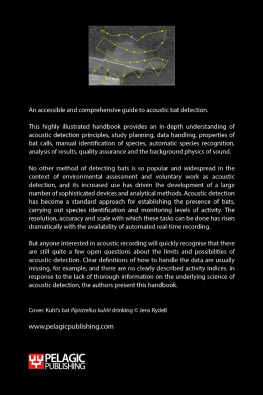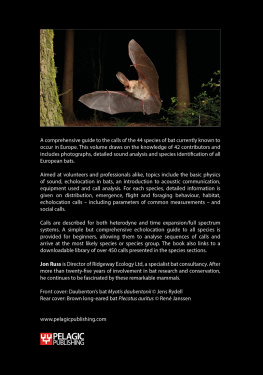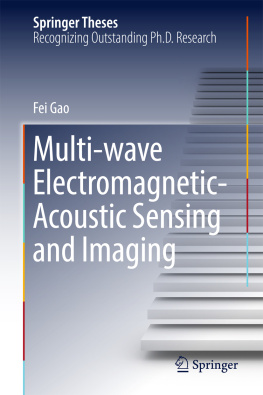
The Handbook of Acoustic Bat Detection
The Handbook of Acoustic Bat Detection
Volker Runkel, Guido Gerding and Ulrich Marckmann
Translated by Iain Macmillan
PELAGIC PUBLISHING
Published by Pelagic Publishing
PO Box 874
Exeter
EX3 9BR
UK
www.pelagicpublishing.com
The Handbook of Acoustic Bat Detection
Originally published in German as Handbuch: Praxis der akustischen Fledermauserfassung
ISBN 978-1-78427-220-3 Paperback
ISBN 978-1-78427-221-0 ePub
ISBN 978-1-78427-222-7 ePDF
Copyright 2021 Volker Runkel, Guido Gerding and Ulrich Marckmann
Translated by Iain Macmillan
The moral rights of the authors have been asserted.
All rights reserved. Apart from short excerpts for use in research or for reviews, no part of this document may be printed or reproduced, stored in a retrieval system, or transmitted in any form or by any means, electronic, mechanical, photocopying, recording, now known or hereafter invented or otherwise without prior permission from the publisher.
A CIP record for this book is available from the British Library
Cover image: Kuhls bat Pipistrellus kuhlii drinking. Jens Rydell
Typeset by BBR Design, Sheffield
Echolocation is sometimes just easier on the eyes
Contents
Since this book is a product of the authors spare time, it has been longer in coming than originally planned. However, we hope that it has been well worth the wait! The aim of the second edition of this book, now under a new title, has been to incorporate suggestions from readers and to add content that did not make it into the first edition, published in German in 2018.
Acoustic bat recording has enjoyed an incredible and unprecedented increase in popularity among volunteers, scientists and professional writers of environmental reports. One of the reasons for this is the need for evidence when evaluating the effects on bats of new developments, above all wind farms. Only a few years ago, the use of data tended to be very unscientific and amateurish, but the huge number of very advanced devices now available on the market has opened up the prospect of all sorts of interesting and exciting projects. A new approach has become established, and has taken bat research and environmental impact assessments to a new level of sophistication.
Anybody involved with acoustic recording will be quick to admit that, despite all the euphoria, there are still many unanswered questions concerning the benefits and limitations of the new techniques. And there is a lack of clear guidelines on the processing of data. There are, for example, no clearly defined activity indices.
The aim of this book is to fill that gap and provide an overview of the applications of acoustic bat recording. It will not generally be possible to include exhaustive technical comparisons of recording equipment. The intention is rather to deal with some of the numerous questions relating to its practical use. The key technical concepts needed for working with ultrasound, and the scientific principles underlying it, are explained in the final chapter.
The authors have many years of experience with acoustic recording and the development of hardware and software for the recording and analysis of bat calls. We would like to thank the many people who, in numerous discussions, have directly or indirectly contributed to the development of this book. There are too many to name everybody, but we owe particular thanks to the following, in alphabetical order: A. Benk, L. Grosche, J. Koblitz and U. Rahmel. I would also like to express my particular gratitude to Otto von Helversen, who made it possible for me, Volker Runkel, to devote myself to the world of bats.
I started working on bats and bioacoustics in 1996 at the University of Erlangen, in Professor Otto von Helversens lab. We had access to tools that were not available elsewhere. Soon after I started my studies there, the first digital bat recorder with a high sampling rate and designed for field use was built by engineers at the university. Yet throughout most of those early years we were working with the standard bat detector, typical for Germany: a heterodyne detector. Nearly all bat workers in Germany used heterodyne systems. Thus, when talking about a bat detector we all had a clear picture of a device that has a frequency dial and makes the typical heterodyne noises.
We had read about the Anabat system, and knew at least one person working with it in Germany. We also had a simple frequency division detector. But it did not compare well with our heterodyne systems, so we never used it. Hence, the concept of frequency division was not part of our bat work.
With the availability of the universitys real-time recording system, Anabat systems were also not interesting for our research. Time expansion detectors, mostly the Pettersson D240x, quickly dominated the bat worker market in Germany. From there it was only a small leap to the batcorder-system, which became the standard tool for consultants in Germany.
While finalising the translation of this book with the valuable help of Philip Briggs, I got new insights into how bat work is done in the UK it is completely different to the situation in Germany. In the UK, frequency division is quite common and is used not only in actively searching for bats but also to record their calls for analysis. It is still used just as heterodyne detectors are in Germany; this is a method I have never used and was not much aware of. Kind of a cultural difference. Considering these fundamentally different techniques made it clearer to me how data is interpreted in the UK and which measurements are used for species identification and call description. One might think that all bat workers employ the same or similar approaches, but the history of detector techniques reveals how work is conducted in different places.
In this way, Philip has done great work to add some of these concepts to the book and thus raise the value of its content. Without him, certain chapters would have been misunderstood by many English-language readers. And all this with only small differences between our countries and with the same bat species and indeed for some species even the same individuals!
Volker Runkel, March 2021
The presence of bats in flight can easily be verified by acoustic methods, since they emit echolocation signals at regular intervals of between 2 and 20 times a second. Bats use these sounds and the resulting echoes to navigate and to find their prey (Griffin et al. 1960; Griffin 1995). These ultrasound signals are generally not audible to the human ear, and so a technical device, a bat detector, is needed to capture them. Nowadays, there is a wide variety of devices to make bat calls audible to the human ear or store them for later analysis. The technical differences between the devices determine their field of application and their reliability in the detection and identification of bat species. Not all devices are equally suitable for every task.
There is a large number of heterodyne, frequency division and time expansion detectors (for manual or hand-held operation) as well as direct sampling (also known as full spectrum) systems (for automated operation). A feature of the latter is that the sound is digitised directly and stored without modification. Descriptions of the technical details can be found in , Heterodyne detectors, onwards). Only some of the available solutions are ideally suited to autonomous operation (passive monitoring). Using a bat detection system is not always problem free, and the recording quality is sometimes not good enough for reliable identification of species, whether carried out manually or automatically.
Next page









